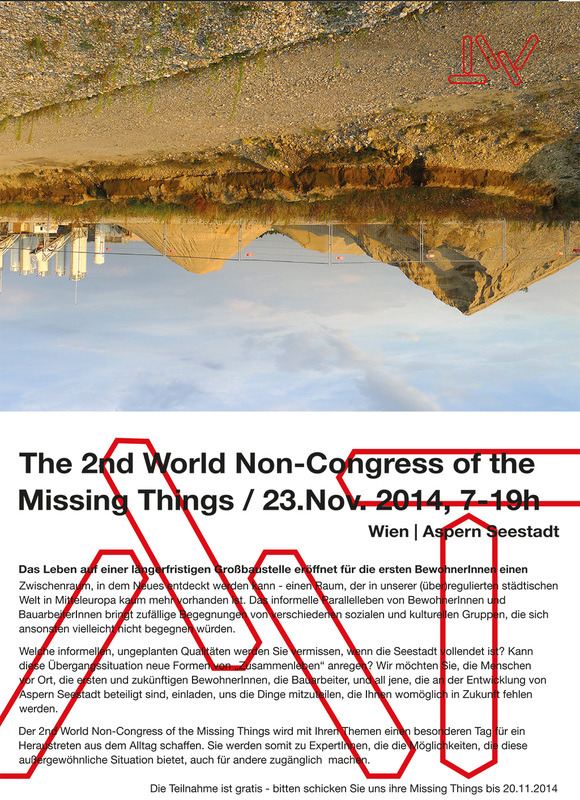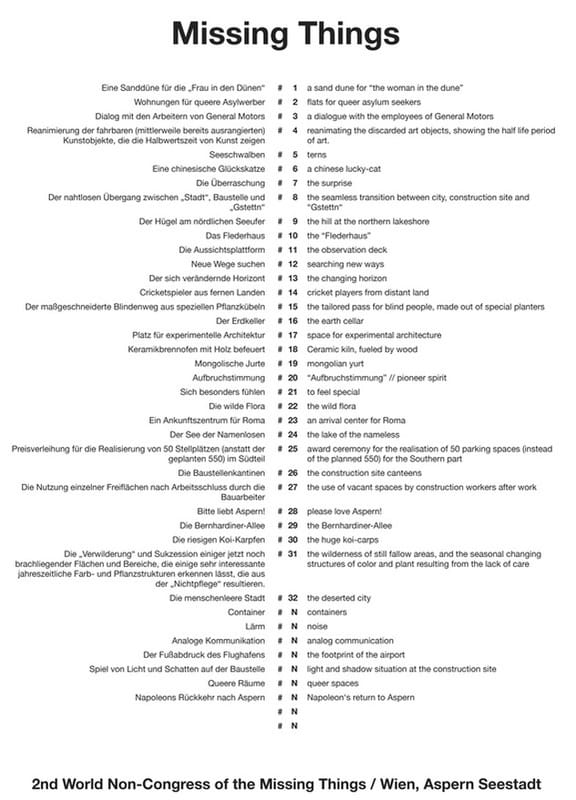|
The Second World Non-Congress of the Missing Things
The “Second World Non-Congress of the Missing Things” at Aspern Lake City explored the urban conditions and the current state of the largest of Vienna’s new city development projects. Now that the first “settlers” have arrived, construction in Aspern will go on for another 15 years. This “non-congress” is based on the “First World Congress of the Missing Things”, which took place in Baltimore (USA) from June 7-8, 2014. The “First World Congress of the Missing Things” and the “Second World Non-Congress of the Missing Things” are embedded in rather contrasting conditions and therefore require different artistic means. Baltimore has suffered a long process of shrinking since the 1950s due to the post-industrial situation resulting in “white flight” from the city to the countryside. Currently there is hope that the once vibrant city center of Baltimore, which has undergone major decay, might be reanimated. The “First World Congress of the Missing Things” took place precisely in this contested area, shifting the usual concept of a congress from being an exclusive meeting of experts to an open-access event in public urban space. The current users of this public urban space ‒ homeless people, ex-convicts, drug addicts, shopkeepers, etc. ‒ were given back a public voice. They were invited to produce the contents of this unusual congress themselves and to claim expertise on these contents. In order to counteract possible unwanted consequences of the anticipated revitalization, which often results in gentrification in US cities, the “First World Congress of the Missing Things” did not only accumulate “things” the people of Baltimore “missed”, which were then handed over to the mayor at the closing ceremony as a “Charter of the Missing Things”, but it also proposed ideas on how to involve locals in processes and provide new perspectives for them in subsequent steps. As an art project engaging in urban societal issues, the “First World Congress of the Missing Things” in the shrinking city of Baltimore introduced an artistic strategy for producing contents beyond the obvious by shifting the expertise to the people who use a given space on site. This format was then explored under very different circumstances in the “Second World Non-Congress of the Missing Things”, which took place amidst a new urban development project in a growing city characterized by a pioneer spirit – even though a few expectations have already been disappointed. The participants of the “Second World Non-Congress of the Missing Things” at Aspern Lake City were, again, the people on site: current and future inhabitants, construction workers and neighbors. As of now, the new residents are enthusiastic about the special conditions they encounter, as they make them feel special themselves. But what happens when all of this becomes normal, upon completion? How can the qualities of the improvised, the unplanned, be maintained? What might be missing when this new urban development project is realized in full scale and when, according to a conventional understanding of planning, “nothing” will be missing anymore? The remnants of public art interventions of recent years have already developed a patina, becoming the first signifiers of Aspern Lake City’s young history thus acquiring a special quality in front of the new skyline that will arise from the first building blocks. Temporary canteens have been established for the construction workers. Accompanied by the notion of improvisation, these places provide more than food: they became knots of informal social interaction. The “Second World Non-Congress of the Missing Things” is considered a “non-congress” because conditions are very different from Baltimore. Even though this event was also publicly accessible, it did not cater to a large audience. It created a “state of exception” for one day, a Sunday, inviting people to step out of their everyday routine. Contributions of missing things anticipated by the users on site and future residents were transformed into small performative interventions by students of Social Design /University of Applied Arts, Vienna, and national and international guests. For more information please visit: www.missingthings.org |
A project by Barbara Holub
realized by students of the University of Applied Arts Vienna/ Dept. Social Design Vienna Aspern Lake City November 23, 2014, 7am to 7pm assistant: Marie-Christin Rissinger .................................... Revolution Without Movement Nov 27, 2014, 7pm tranzit, Bratislava curated by Berit Fischer & HIT Gallery Presentation of the “First World Congress of the Missing Things” and the "Second World Non-Congress of the Missing Things" |

